myths of summer
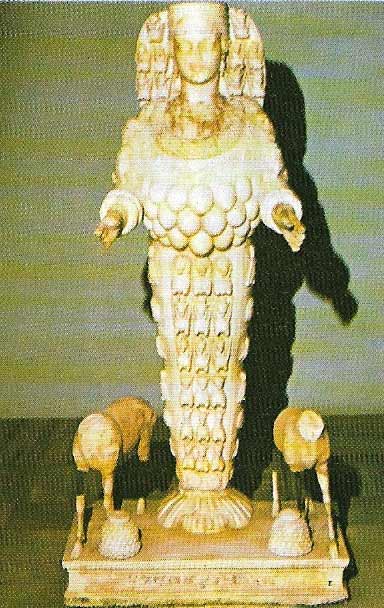
Figure 1. Diana of Ephesus (not to be confused with the Roman huntress Diana) was probably of ancient Asiatic origin, although the Greeks found her temple and worship established in Ionia. Her prodigious power to suckle infants is portrayed by her many breasts. Multiplication of an attribute to suggest prowess is seen also in the Hindu pantheon whose gods often have several arms, legs, or even heads.
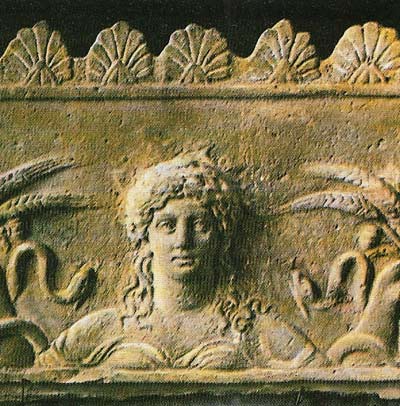
Figure 2. Demeter, identified by the Romans with Ceres, was the Greek goddess of the fruitful earth and protectress of marriage and social order. This terracotta head shows her with her attributes of corn, poppies, and snakes. Demeter was especially the goddess of corn: wheat and barley were sacred to her, and she presided over the harvest and all things associated with it. In her capacity as goddess of marriage, she was regarded as a beneficent lawgiver to mortals. But in some parts of Greece her primitive nature was emphasized; there she was represented by a horse's head ringed with wild beasts, in her hands were a dove and a dolphin.
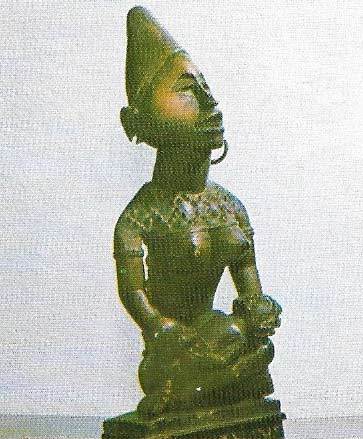
Figure 3. Female figures, often holding children, are commonly kept in Bakongo ancestor cult shrines in Angola, to honor the founders of the family. From the viewpoint of union and fertilization, birth is the harvest; from the viewpoint of the newborn infant the cutting of the cord separates one state of existence from the last. The cycle leads from original unity through separations and initiations to final reunification. Familiarity with the phenomenon of birth does not des-troy a sense of awe.

Figure 4. Medusa was the only one of the three Gorgons, the daughters of the ancient sea gods Phorcys and Ceto, who was mortal. Her head (from a 3rd-century AD Roman mosaic) was covered with snakes in place of hair, and struck such terror in the beholder that it turned him to stone. Perseus, armed with the cap of Hades to make him invisible and guided by Athene, succeeded in cutting off her head by sighting it in a polished shield and striking it with a sickle.
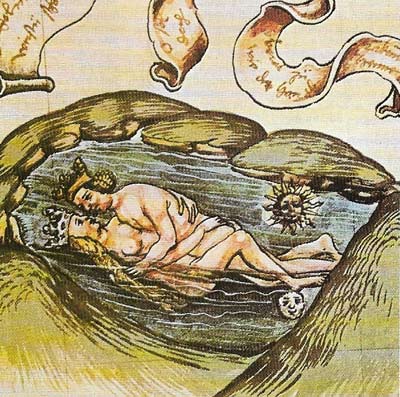
Figure 5. Marriage is a social institution not much honored in mythology (especially not by Zeus) apart from occasional praise of marital fidelity, as in the story of Penelope waiting for Ulysses to return. Sexual union, however, is exalted in widely differing cults and rituals. In this 16th-century alchemical version of "the sacred marriage", king and queen, sun and moon join together, their dissimilar elements dissolving and merging in the water.
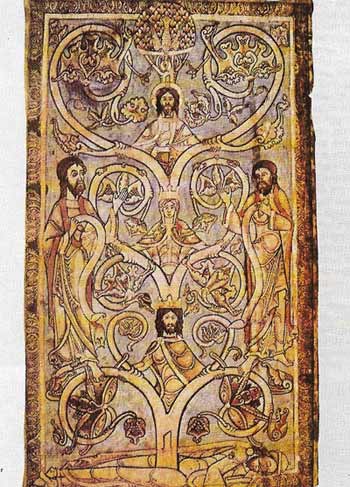
Figure 6. The branches of the Tree of Jesse, in this 12th-century French version, support his descendants, David, the Virgin Mary and Jesus. Like Sarah before her, Anna, mother of Mary, was barren for 20 years until "the Lord took mercy". The symbol of a tree as axis of the world is not unusual. Adonis, the Greek god of vegetation, was said to have been born from the trunk of a myrtle.

Figure 7. Pan, son of Hermes, with the legs, horns and beard of a goat, was a phallic shepherd-god of the pastures and woods who made the flocks prolific. He was worshipped originally in Arcadia and his cult spread throughout Greece in the 5th century BC. His revels, depicted here by Nicolas Poussin (1594–1665), were similar to those of Bacchus, the god of wine, called bacchanalia. Pan frolicked with nymphs at night but liked to frighten travellers, hence "panic".
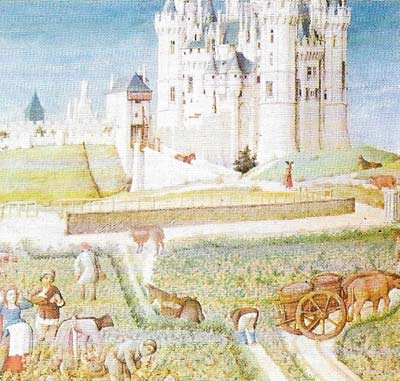
Figure 8. Summer is a time of ripeness and the full power of the sun's energy. Wine harvesting is associated with Dionysus, god of wine, who represents the intoxicating power of nature.
Summer, with the sun at the height of its power, is understandably associated with images of the hero's achievement and female receptiveness. The myths of this season embody the idea of the union and the fruit of sky and earth on the sexual and reproductive planes as well as the spiritual.
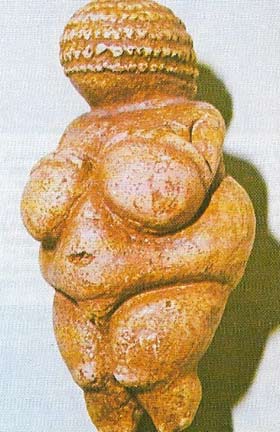 |
| Surviving myths almost invariably portray the supreme deity as male. But extremely old objects such as this "Venus" (c. 20,000 BC) suggest that earlier the Earth – the most revered of the gods, giver and taker of life – was represented as a woman and mother. This crude figure is hardly beautiful, unlike the Venus of the Romans yet it suggests an awe-inspiring strength. |
Woman as goddess
There can be little doubt about mythology having been told and recorded from a man's point of view. Woman is regarded as the second sex, a newcomer to creation and a definitely inferior and possibly evil one at that. Myths describing the transformation and psychological development of the individual rarely have a heroine as the centerpiece. The story of Eros and Psyche is one of the few. Woman is usually shown to play diametrically opposed roles in mythology – as a source of life, on the one hand, and as a dangerous temptress and ruthless destroyer on the other.
Given that on one level myths reflect human emotions and attributes, there are several possible explanations for this equivocal attitude. One is that women are seen as different sexually, and intolerance for what is different is a consistent characteristic of mankind. When this "other" is also desired, then it may be loathed and feared as well as loved and idealized. Another explanation stems from a baby's experience of its mother. This earliest and most formative relationship seesaws (erratically as far as the baby is concerned) between a warm, protective love and anger and punishment. Consequently an ambivalent attitude towards women develops. Women and the goddesses who represent them come to symbolize the dread aroused by the unpredictable hazards of man's life.
The mother goddesses round the world are seen equivocally as givers and takers of life, as personifications of Earth, as creators of animals and vegetation and as goddesses of love, marriage and maternity. They appear, with some or all these characteristics, under many names: as Kali (India), Inanna (Sumeria), Ishtar (Babylon), Astarte or Anat (Canaan), Aphrodite, Demeter and Artemis (Greece), Cybele and Venus (Rome), Isis (Egypt), Ma (Anatolia), and Freya (Scandinavia). Their rites range from the decorous to the orgiastic and sometimes include temple prostitution.
The hero and women
The hero's encounters with women reveal man's attitude towards women and also embody lessons about how man comes to terms with the conflicting urges in his nature. There is an initial theme of separation from the dangerous (or incestuous) union with the mother. Subsequently, woman, in the form of the fair maiden or the king's daughter, becomes a hard-won prize, either as the goal of the hero's quest or as a helper, inspiring him to accomplish his mission, as Ariadne did when she fell in love with Theseus.
He had come from Athens to King Minos of Crete to pay the yearly tribute of seven youths and seven maidens whose fate was to be devoured by a monster bull, the Minotaur, which lived in the labyrinth. Without the thread that Ariadne gave him, he would not have found his way out of the labyrinth where others had perished. But in terms of his psychological development, his triumph seems premature. Although he carried Ariadne off, she got little thanks for her love and he abandoned her on a small island. Easy victories had spoilt him, so it is not surprising that he had further trouble with women. His capture, marriage and subsequent repudiation of the Amazon Antiope led to the invasion of Athens, as did his treatment of the young Helen, whom he carried off from Sparta. This story may be interpreted as a cautionary tale. Manhood is not easily acquired and without it woman remains a threat, a devouring, dangerous creature, whether in human form or, as often classically portrayed, as an evil monstrosity, such as Medusa, that needs to be slain (Figure 4).
Other elements of this theme are contained in one of the oldest epics recorded, that of Gilgamesh. The story of his partnership with Enkidu, a wild, barely human creature who had been captured while he was being seduced by a temple prostitute, their killing of a ferocious giant and the "bull of heaven", and Enkidu's death at the hands of the angry gods, contains among other themes allusions to an incomplete development of heterosexuality. In psychological terms, the message is that fear of the opposite sex is overcome not by contempt (killing the monster), not by tributes and worship, but by the granting of equal status to the essential otherness of the opposite sex, recognizing its common humanity.
The pendulum of mythology
Mythological thinking, like man's nature itself, may be compared to a pendulum that swings between the earthy or biological and the more abstract or spiritual (Figure 2). Myths surrounding fertilization and childbirth show this wide spectrum particularly well. Zeus coupled with Leda in the form of a swan. When he fertilized Danad (who gave birth to Perseus, slayer of Medusa) he did so as a shower of gold leaking through the roof of her prison. As the pendulum swings back, man's mythological thinking has matured and he accepts images of ordinary sexual intercourse, although perhaps under somewhat unusual circumstances, as the symbolic union of opposite qualities in general (Figure 5).
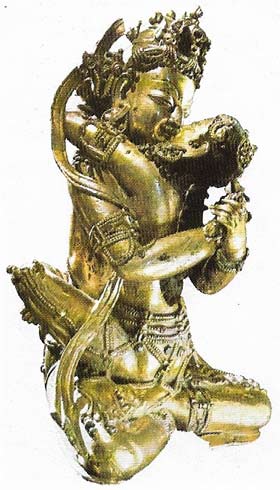 |
| The yogic posture known as Yab-Yum (Father-Mother), seen in this 18th-century Tibetan bronze, unites the Hindu male god or "absolute reality" with his female counterpart, Shakti. No greater contrast can be imagined than that between this and the denial of sexuality in Christian tradition, although May is often called the consort of God. The female emanation of the Hindu god is called Lakshmi (in the case of Vishnu) or Parvati (in the case of Shiva). As the latter, she is portrayed as a beautiful young woman sitting close to her husband. The imagery of sexual union is also delicately expressed in a linear design of interlaced triangles which is called Shri-Yantra. |
